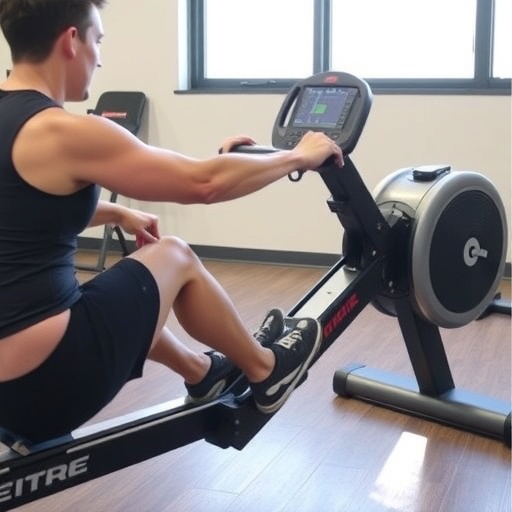Recent studies have brought forth a significant exploration in the realm of rowing training, particularly focusing on the mechanical power output measurement of the RP3 rowing ergometer. This device, which is favored by athletes and coaches alike, has claimed to revolutionize rowing performance metrics through its advanced measurement capabilities. However, the validity of its power output assessment has been a subject of scrutiny and debate among sports scientists. A pivotal study conducted by Mentz, Winkert, Steinacker, and colleagues examines the accuracy and reliability of this measurement tool, providing crucial insights into its effectiveness.
The study emphasizes the growing need for precise measurement instruments in the sports industry, particularly in rowing, where performance can be intricately tied to minute variations in power output. The authors argue that accurate power readings are essential for training regimens as they can inform the coupling between training loads and athlete performance. Inaccuracies in these measurements can potentially lead to mismanagement of training loads and strategies, ultimately affecting an athlete’s competitive edge.
Using a methodical approach, the researchers undertook an extensive validation of the RP3 ergometer’s mechanical power output measurements against established industry standards. Their methodology involved rigorous testing across various conditions and subjects, allowing for a comprehensive evaluation of the ergometer’s performance. These tests were designed to replicate real-world rowing scenarios, ensuring that the data gathered would be representative of actual performance situations.
The implications of their findings are profound, particularly in understanding how ergometers can deliver consistent and valid power output metrics. By utilizing a cohort of trained rowers, the authors were able to draw parallels between the mechanical power evidenced on the RP3 and actual performance data gathered from water-based rowing. Such comparative studies are vital, as they not only lend credibility to the ergometer’s readings but also establish a trust factor for athletes and coaches who depend on these technologies for training enhancement.
One key aspect addressed in the study is the variance in power output across different rowing strokes and techniques. Depending on the rower’s style, the ergometer may record fluctuations that could either enhance or undermine the perceived training effectiveness. The researchers delve into these variances, shedding light on how slight adjustments in technique can lead to significant discrepancies in power readings. This revelation is crucial for coaches who seek to optimize training regimens tailored to individual rowing styles.
Furthermore, the study extensively discusses the mechanical intricacies of the RP3 rowing ergometer. Readers are introduced to the technology behind the unit, including the innovative sensors that measure stroke dynamics and the algorithms that translate these strokes into tangible power outputs. Detailed technical explanations illustrate how the machinery interacts with physical movements, underscoring the ergometer’s role as more than just a static tool; it is an enabler of performance analytics.
As rowing continues to evolve as a competitive sport, so too must the technologies that underpin its training methodologies. The authors argue that innovations must be continuously assessed and validated to keep pace with evolving athletic performance standards. This notion cultivates a culture of trust in technological advancements, prompting greater investigation and refinement of tools like the RP3 ergometer.
Clinically speaking, the findings presented in this research not only impact competitive settings but also extend to rehabilitation and physical therapy contexts. Rowing can serve as a low-impact exercise regime, and having precise power output readings can assist physiotherapists in designing better recovery programs for athletes coming back from injuries. Such cross-disciplinary implications highlight the versatile nature of the rowing ergometer and its potential far beyond traditional athletic training.
Discussions surrounding the study suggest future directions for research. The authors propose further investigation into how individual physiological differences, such as height, weight, and rowing experience, impact mechanical power output. These factors could lead to a more nuanced understanding of how ergometers can be tailored to enhance individual rower performance. Such studies stand to strengthen the overall credibility of power output measurements and the technology on which they rely.
In summary, the RP3 rowing ergometer has made an indelible mark in the rowing community by providing athletes and coaches with a sophisticated means of tracking performance metrics. The validation study conducted by Mentz and colleagues corroborates the instrument’s efficacy, paving the way for its continued use in both training and rehabilitative settings. With the advent of scientifically-backed performance metrics, rowers are better equipped to harness their potential, optimize their training, and ultimately surge forward in their competitive endeavors.
This pivotal study underscores the integration of technology in sports, revealing how modern innovations can align with traditional training techniques. As the landscape of athletic performance measurement continues to evolve, the need for studies that scrutinize and validate these technologies will remain crucial. The findings from Mentz et al. serve as a foundational step in ensuring that rowing athletes can train with confidence, knowing their power outputs are both reliable and actionable in pursuit of their competitive goals.
In conclusion, the evolution of rowing training technology is no longer a trend but a necessity. The insights gleaned from this study emphasize how integral accurate measurements are to not just the training process but to the overall enhancement of athletic performance. As the field evolves and innovation drives progress, the power output assessment of ergometers like the RP3 will continue to shape and influence the future of rowing—one stroke at a time.
Subject of Research: Mechanical power output measurement of the RP3 rowing ergometer
Article Title: Validity of the RP3 rowing ergometer’s mechanical power output measurement
Article References:
Mentz, L., Winkert, K., Steinacker, J.M. et al. Validity of the RP3 rowing ergometer’s mechanical power output measurement.
Sports Eng 28, 24 (2025). https://doi.org/10.1007/s12283-025-00504-9
Image Credits: AI Generated
DOI:
Keywords: Mechanical power output, RP3 rowing ergometer, rowing performance, training methodologies, sports science.




